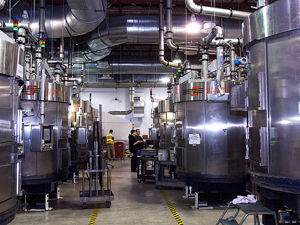6 Things You Need to Know to Get Certified Under ISO 50001
<p>During a webcast organized by GreenBiz.com this week, representatives from the US Department of Energy and Underwriters Laboratories walked through the details of the just-released energy management standard, and how companies can get on board, quickly.</p>

During a free webcast organized by GreenBiz.com this week, representatives from the US Department of Energy and UL DQS walked through the details of the just-released energy management standard, and how companies can get on board, quickly.
GreenBiz executive editor Joel Makower, who moderated the panel, started off by describing ISO 50001 as a new tool that will establish a framework for industrial plants, commercial facilities and entire organizations to manage energy.
When the standard achieves widespread adoption, it's estimated that ISO 50001 could influence up to 60 percent of the world's energy use.
To talk about how companies can get certified, and to walk through some of the challenges faced in the process, two expert panelists joined the webcast: Paul Scheihing, the Technology Manager for the U.S. Department of Energy's Industrial Technologies Program; and Jerry Skaggs, the Environmental, Health, Safety and Energy Program Manager at UL DQS.
ISO 50001 requires continuous improvement, but not specific requirements, which is where the ITP program comes in, to have specific requirements of improvement. The value of the certification, Scheihing said, is that for the first time it provides a framework for continual improvement for facilities on energy performance, and across the entire organization.
To be certified, you have to conform to the ISO 50001 management standard, and you have to improve your energy performance, and get both aspects certified under a third party. There are 24 companies working in the pilot mode of ISO 50001, across all types of manufacturing sectors and at all sizes.
Between 2008 and 2010, five initial facilities in Texas were piloted, and have been certified to date. Scheihing said the energy improvements achieved at the facilities ranged from 6.5 percent to 17.1 percent over a three-year period.
Among the initial feedback from the pilot project include the benefits of having a cross-functional plant energy management team that goes beyond just operations or engineering means that energy management becomes a shared responsibility, and that makes it much easier to incorporate significant changes in energy use.
One of the biggest shifts that the pilot projects found was that as a result of going through ISO 50001 certification, energy management became a way of doing business, instead of a project-by-project undertaking.
"We're changing the mindset in plants to looking more proactively to manage your energy, rather than just seeking the lowest energy costs from your utility," Scheihing said.
Scheihing laid out six steps that any organization can take to get started on ISO 50001 today:
- Secure support from top management;
- Collect, track, and analyze energy data;
- Identify key energy uses;
- Establish a baseline;
- Identify energy-saving opportunities;
- Prioritize opportunities
The Department of Energy has created a new website for energy management, which lays out an overview of ISO 50001 and offers case studies and tools to help companies undertake those first steps.
Jerry Skaggs from UL DQS followed on Scheihing's presentation to walk through each of the six steps, as well as a checklist for organizations to follow once they've gone through the process to ensure proper implementation and follow-through.
In the end, there are a number of benefits to effectively implement an energy management system, including:
• Reduced operational and overhead costs lead to increased profitability
• Reduced air emissions, such as GHGs
• Increased efficiency of energy sources
• Increased assurance of legal, internal compliance
• Variables affecting energy use and consumption are identified
• Increased understanding of energy use and consumption via defined methods, processes of data collection
UL DQS, which brings the Management Systems Solutions division of Underwriters Laboratories together with DQS, a German management certification company, offers a number of specialized services for helping companies assess and implement opportunities for energy management, including ISO 50001 certification.
This week's webcast was the second event tied to the launch of ISO 50001; the first, ISO 50001: Preparing for the New Energy Management Standard, took place in May and is archived for one year.
To hear the full discussion of ISO 50001, as well as get links and tips on how your company can get involved with an energy management system, see the full webcast, ISO 50001: The Six Things You Need to Know, which is accessible for free until July 2012.
Photo CC-licensed by OregonDOT.





